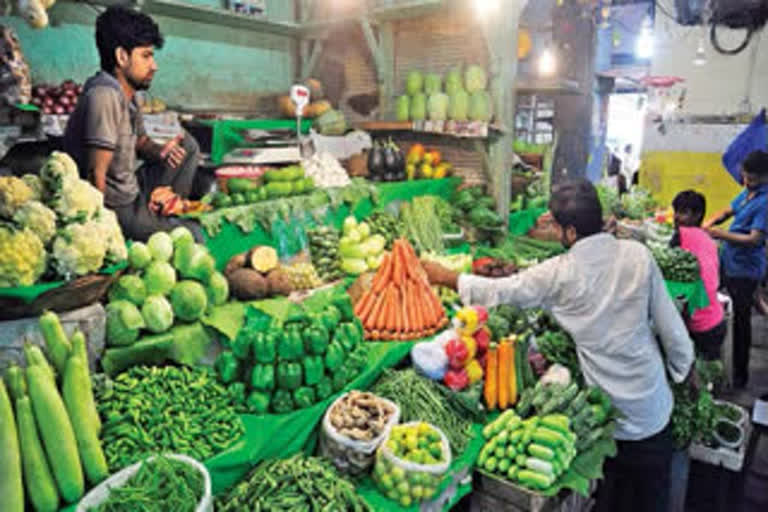New Delhi: Rising prices of edible oils and protein rich items pushed the retail inflation to a six-month high of 6.3 per cent in May, breaching the comfort level of the Reserve Bank and thus rendering reduction in interest rates a difficult proposition in the near term. The government has asked the Reserve Bank to keep the retail inflation at 4 per cent with a margin of 2 per cent on either side. CPI inflation has breached the upper band of the inflation target about 10 times since the first meeting of the Monetary Policy Committee (MPC), which decides the key interest rate, in October 2016.
Wholesale price-based inflation too accelerated to a record 12.94 per cent in May on account of rising prices of crude oil, manufactured goods and the low base of last year due to the COVID-19 lockdown. While the Consumer Price Index (CPI)-based inflation rose from 4.23 per cent in April to a six-month high of 6.3 per cent, food inflation soared from 1.96 per cent to 5.01 per cent in May. The previous high in retail inflation was 6.93 per cent in November 2020.
In May 2020, the Wholesale Price Index (WPI)-based inflation was (-) 3.37 per cent and in April 2021, it hit double digits at 10.49 per cent. This is the fifth straight month of uptick seen in WPI inflation. As per the data on CPI, factored in by the RBI while arriving at its monetary policy, the steepest price rise was witnessed in the 'oils and fat' segment, which on an annual basis showed an increase of 30.84 per cent. The May CPI data released by the National Statistical Office (NSO) further revealed that the rate of price rise in 'meat and fish', 'egg', 'fruits', and 'pulses and products' stood at 9.03 per cent, 15.16 per cent, 11.98 per cent, and 9.39 per cent, respectively.
Read More: Wholesale inflation hits record high of 12.94% in May on costlier fuel
The rate of price rise in the 'fuel and light' category quickened to 11.58 per cent. As per the WPI data, released by the Commerce and Industry Ministry, the wholesale inflation in fuel and power basket spiked to 37.61 per cent during May, against 20.94 per cent in April, amid hardening of global commodity prices. In manufactured products, WPI inflation stood at 10.83 per cent in May, against 9.01 per cent in the previous month. However, the wholesale inflation in food articles eased marginally to 4.31 per cent in May, even as onion prices spiked.
The rate of price rise in onion stood at 23.24 per cent in May, as against (-)19.72 per cent in April. Commenting on the CPI data, Aditi Nayar, Chief Economist at ICRA Limited, said the retail inflation has hardened to a six-month high in May, with an alarming 207 bps jump relative to April. "We have raised our forecast for the FY2022 average CPI inflation to at least 5.4 per cent. However, we believe the MPC will demonstrate a high tolerance even if the average CPI inflation ranges between 5.5-6 per cent in FY2022, given the uncertainties regarding the growth outlook.
"Therefore, we continue to expect a status quo on the repo rate and a continuation of the accommodative stance through 2021," she said. On edible oil prices, Suresh Nagpal, chairman of Central Organisation for Oil Industry and Trade (COOIT), the apex association of edible oil manufacturers and traders, said prices of cooking oils were high in May because of a rise in global prices. "However, rates of edible oils in the wholesale market have started to soften from this month. Rates of cooking oils in retail markets will soon start to ease. This will get reflected in Inflation numbers of June and July," he said.
Radhika Rao, Economist and Senior Vice President, DBS Singapore, said inflationary pressures are evident in certain food components and successive increases in retail fuel prices spurred by tax rigidity as well as spurt in core inflation to 6.6 per cent. "Besides higher transport, the latter also likely reflects anecdotal signs that selected non-food categories especially medical inputs (medicines etc) and hospitalisation costs rose this quarter in midst of the second pandemic wave.
Read More: RBI keeps repo rate unchanged at 4%
"This outcome complicates the direction of monetary policy...Policy normalisation expectations are likely to be increasingly priced in as vaccination approaches critical mass in first half of 2022," Rao said. On wholesale inflation, PHDCCI President Sanjay Aggarwal said high fuel inflation is escalating the input costs of the industry, affecting its competitiveness in the domestic and international markets. "At this juncture, we urge the government to consider petroleum products in the ambit of GST to rationalize the prices and to contain the rising inflation," Aggarwal added.
ITM B-School HoD, Financial Markets, Krupesh Thakkar said though the RBI might not look into these numbers too cautiously, these cost-push pressures would be seen in the retail inflation with a lag. "Of course, the yearly Consumer Price Index (CPI) figures do depend on its segment weightage and relative base impact, but these pressures cannot be ignored," Thakkar added. The RBI had left the key interest rate unchanged earlier this month.
The central bank has projected the CPI inflation at 5.1 per cent during 2021-22 -- 5.2 per cent in Q1; 5.4 per cent in Q2; 4.7 per cent in Q3; and 5.3 per cent in Q4 of 2021-22, with risks broadly balanced.
(PTI)



